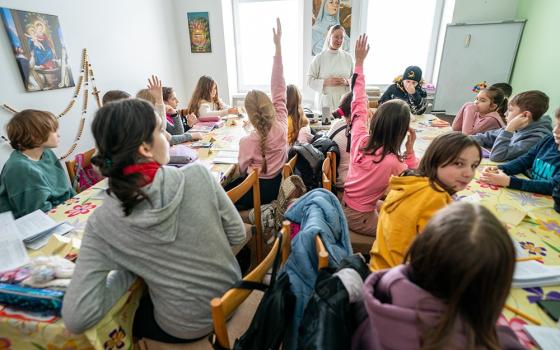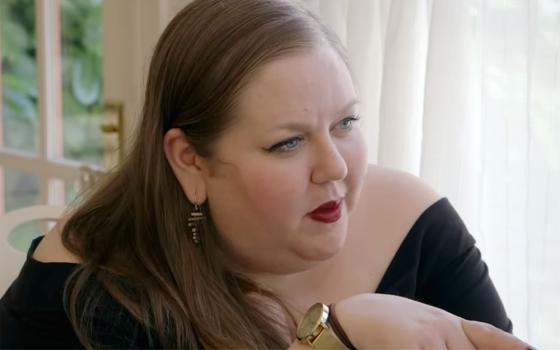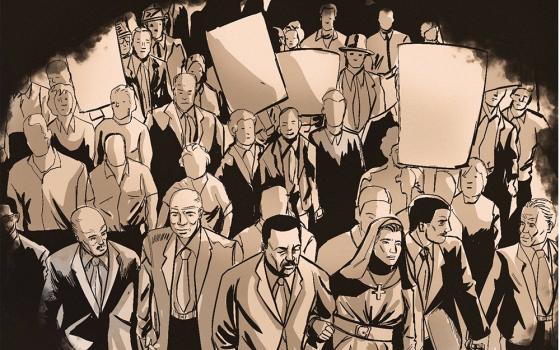
At the opening of the 19th century, Sr. Therese de St. Xavier Farjon was in charge of the Ursuline sisters in the Louisiana territory. In 1804, Farjon wrote to President Thomas Jefferson, whose government had just purchased Louisiana. Could the Catholic institutions in the former French colony remain independent and unfettered under the new government? Farjon asked the president.
Jefferson wrote back: “Your institution will be able to govern itself without interference from civil authority.”
“That is a really important document. Many legal scholars interpret the letter as [Jefferson’s] clear endorsement of religious freedom in a secular state,” said Helen Maher Garvey, a Sister of Charity of the Blessed Virgin Mary and chair of the history committee for the Leadership Conference of Women Religious.
The letter is among the artifacts, images and multimedia displays that are part of the exhibition “Women and Spirit: Catholic Sisters in America.” The 3,200-square foot exhibition opens in Cincinnati in May and starts a three-year tour of history museums across the country. (See schedule below.)
The exhibit is a project that the Leadership Conference of Women Religious began as a celebration of its 50th anniversary.
“There is a lot of myth and mystery out there about Catholic sisters. We would like to tell the true story, with its rise and fall, its glory and its concerns,” Garvey said.
Popular images -- like the 1960s television show “The Flying Nun” or the dinner-theater musical “Nunsense” -- play up stereotypes of women religious and distort their true place in history, according to Garvey.
“We started this exhibit out of an intense desire to share the history of the Catholic sisters and their contributions to the history and culture of the United States,” Garvey said. “The sisters feel very strongly that it is an untold story.”
The true history, as the exhibit documents it, is that religious women were more often than not at the forefront of trends that shaped this country, as leading figures, like Farjon, or in minor parts, like the sisters who were teachers in schools that integrated countless millions of immigrant children into the American mainstream, or helped integrate a racially divided America.
The exhibition tells of sisters who might be called character actors in the great dramas that shaped the nation. Like the 617 sisters from 21 communities who nursed Union and Confederate soldiers on both sides of the Civil War.
Or like Sr. Blandina Segale, an Italian immigrant and Sister of Charity from Cincinnati. On mission in Santa Fe, N.M., Segale nursed an outlaw whom doctors in town wouldn’t treat. The desperado was in Billy the Kid’s gang and Billy came to Santa Fe to kill the doctors who had refused his man treatment. Segale talked the Kid out of murder and saved the doctors’ lives.
Or Sister of Charity of Leavenworth Florence Cloonan, who nursed Ernest Hemingway for seven weeks in St. Vincent Hospital, Billings, Mont., as the novelist recuperated from an auto accident. After his convalescence, Hemingway wrote the short story “The Gambler, the Nun and the Radio.”
The exhibit also tells fascinating stories of sisters whose greatness was the solidarity they shared with ordinary folks while keeping an eye on a larger vision.
Like Mother Mary Frances Sullivan, a Mercy sister. She led the effort for public sanitation in Joplin, Mo., in the 1870s. By digging sewage ditches from the Mercy sisters’ convent to a nearby river, she inspired city officials to begin a communitywide sewer system.
Or Sr. Amata Mackett, who lived among the lumberjacks of northern Minnesota. Mackett represented the Duluth Benedictines, selling insurance policies to the lumberjacks in an era that had no workers’ compensation or social security. Lumberjacks could purchase policies from $1 to $9, giving them up to a year of medical care in the sisters’ hospitals. Mackett baked pies for the loggers and darned their socks. But she wasn’t above going after one with a poker if he was delinquent in his insurance premium.
One surprise of the exhibition is that between 1790 -- when the Ursulines first landed in New Orleans -- and today, the total of religious women in the United States numbers only about 220,000. The 20th century, particularly the mid-20th century, saw a tremendous growth in women’s communities. But before that, their numbers were very small.
According to Mary Gautier, a senior research associate at the Center for Applied Research in the Apostolate at Georgetown University in Washington, the Official Catholic Directory only reports 9,730 women religious in the United States in 1900.
In 1965, the women religious numbered nearly 180,000, according to figures from the center. Today it’s about 59,000.
How could so few accomplish so much?
Garvey explains: “These people were in institutions, and sometimes when you have few people but they are in strategic places like education, health care and social services, they have a tremendous impact. So those women, though relatively few in number, have had a very critical impact on the history and culture of the United States.”
To organize and mount the exhibit, the history committee of the leadership conference raised $4 million. Religious congregations provided seed money to get the project started about four years ago. Major funding came from the Hilton Fund for Sisters ($1 million) and the Catholic Health Association ($500,000). The remainder of funds came from various foundations, religious congregations and Catholic institutions, particularly Catholic health-care institutions.
The exhibition tries to take an honest look at sisters in America, Garvey said. “We are documenting the lives of people who made huge contributions and who also made mistakes along with the rest of the culture.”
One section of the exhibit examines “prejudice within and prejudice without.” A display shows a white bonnet with a fluted frill that Sisters of Charity of the Blessed Virgin Mary wore in Philadelphia between 1833 and 1852. The sisters adopted the bonnet to avoid “nun-like” clothing as a way of protecting themselves from anti-Catholic sentiment at that time. Despite their precautions, the Charity sisters’ convent in Philadelphia was eventually torched by a mob, as was an Ursuline church in Charlestown, Mass.
Also on display is a “slave roll” from Kentucky dating to 1850. A slave roll listed slave owners and the slaves they owned for census and tax purposes. The roll comes from the Dominican sisters of St. Mary’s Convent in St. Catharine, Ky., and lists them as owning slaves.
“The sisters endured discrimination,” Garvey said. “And they participated in discrimination.”
Garvey noted that the display also documents a reconciliation service that took place in 2000. At the service, sisters from three Kentucky orders -- the Dominicans, the Lorettos and the Sisters of Charity of Nazareth -- asked forgiveness for their orders’ participation in slavery.
The exhibit also addresses the 1960s and 1970s, which saw a huge exodus of women from religious life. That part of the exhibit is called “The Signs of the Times.”
“We do note the fact that there was a loss of a large number of sisters at that time,” Garvey said. “We note that this was a time of upheaval within the world and the country and that we did not escape that upheaval.”
“So while we know that we have significantly fewer sisters, we truly believe that religious life will continue into the future,” Garvey said.
The future of religious life for women is evolving as sisters begin to explore what Garvey calls “new frontiers.”
“We have sisters serving in many different ways,” Garvey said. “We certainly still have and uphold sisters in teaching, health care and social services. But we have sisters now in the public realm [such as lobbyists and lawyers]. We have sisters working in the environment. We have sisters who are in parish ministries and diocesan leadership. We have sisters working in areas where generally they did not work before Vatican II. So we’ve had an expansion of ministries.”
Garvey’s last comment could serve as a subtitle for the exhibition: “It’s the plethora and diversity of ministries that enrich us.”
Dennis Coday is an NCR staff writer. His e-mail address is dcoday@ncronline.org.
Artifacts highlight contributions to U.S. history
The artifacts and photographs on display at “Women and Spirit: Catholic Sisters in America” are only a fraction of the material available.
“We have often said that our exhibit is representative but not all-inclusive, because we could not include everything,” Garvey said.
Garvey’s committee sent a letter to every house of women religious in the country asking them to send digital images of the four most important artifacts or photographs from their archives, with short descriptions.
Though everything couldn’t be included, the work of gathering the artifacts and information won’t be wasted.
“We now have a database of significant artifacts from a large number of religious congregations across the United States,” Garvey said. “This in itself is a significant contribution to the history of the United States.”
-- Dennis Coday
Upcoming showings
"Women & Spirit: Catholic Sisters in America" has been scheduled at the following museums:
The Cincinnati Museum Center Cincinnati May 16-Sept. 7, 2009
The S. Dillon Ripley Center The Smithsonian Institute Washington January-April 2010
The Mississippi River Museum Debuque, Iowa February-April 2011
Check the exhibit's Web site for updates: www.womenandspirit.org
Printed in the National Catholic Reporter, February 20, 2009.



